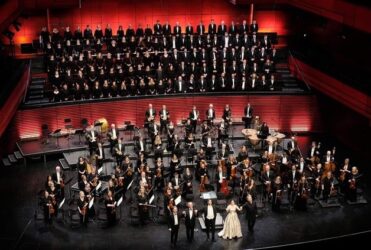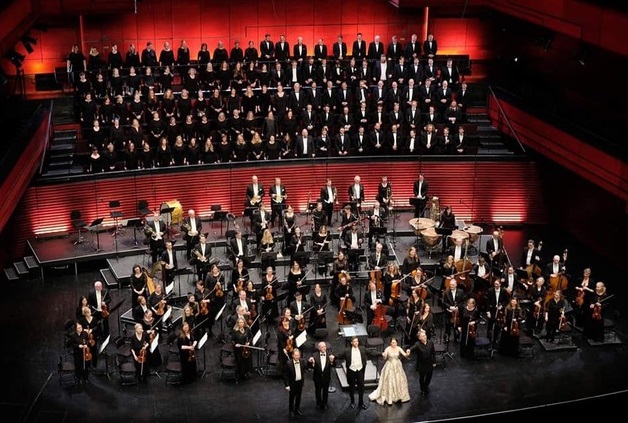 Iceland Messiaen, Brahms: Emily Pogorelc (soprano), Jóhann Kristinsson (baritone), Mótettukórinn, Söngsveitin Fílharmónía, Iceland Symphony Orchestra / Bertrand de Billy (conductor). Harpa, Reykjavik, 17.3.2022. (RP)
Iceland Messiaen, Brahms: Emily Pogorelc (soprano), Jóhann Kristinsson (baritone), Mótettukórinn, Söngsveitin Fílharmónía, Iceland Symphony Orchestra / Bertrand de Billy (conductor). Harpa, Reykjavik, 17.3.2022. (RP)

Messiaen – Les Offrandes oubliées
Brahms – Ein deutsches Requiem, Op.45
In glass, stone and light, the Harpa captures the primeval natural elements of Iceland: the Northern Lights, the columnar basalt structures that dominate its landscape and Reynisfjara, the black sand beach on the island’s southern coast. Its main concert hall, Eldborg, is the regular performance venue for the Iceland Symphony Orchestra; the interior is an intense red with flashes of yellow which evoke the lava that continues to spew forth from Iceland’s 32 active volcanos.
Founded in 1950, the ISO gives weekly concerts at the Harpa and tours internationally, including appearances at venues such as the BBC Proms, New York’s Carnegie Hall and Vienna’s Musikverein. Finnish conductor Eva Ollikainen is the ISO’s Chief Conductor and Artistic Director. For this concert, Principal Guest Conductor Bertrand de Billy led the orchestra, soloists and chorus in works by Messiaen and Brahms.
A profoundly spiritual person, Messiaen sought, above all else, to express the existence of the Catholic faith through music. Composed in 1930 when he was only 22 years old, Les Offrandes oubliées is a meditation on God’s love for man. There is no doubt as to what Messiaen intended to depict musically in the three-part work – The Cross, The Sin and The Eucharist: he described it in detail in program notes written to accompany the piece.
De Billy led a perfectly balanced and deeply moving performance of Les Offrandes oubliées in which Messiaen’s shimmering orchestral textures and colorings were subtly depicted. Fine string playing is essential for this ethereal work to be successful, and the challenge was met and surpassed here. The technical challenges are not as great as the artistic ones, however, especially in the third movement in which de Billy’s refined touch and the ISO’s violin and viola sections combined to create an atmosphere of singular beauty.
Brahms was much less religiously doctrinaire in his Requiem, eschewing the traditional Latin text for excerpts from the Lutheran Bible and Apocrypha in the German language, which he personally selected. Written between 1865 and 1868, Brahms’s lingering sadness over the death of his friend Robert Schumann and, subsequently, that of his mother may have prompted him to create this musical expression of sorrow, comfort and triumph over death. The success of the Requiem elevated Brahms to the front ranks of German composers and brought him international fame.

Performances of the Requiem are common, but it is somewhat rarer to hear one led by a conductor of de Billy’s stature, let alone someone with his sensitivity to text. The most striking element was the balance between chorus and orchestra, which created a carpet of sound where individual sections of the orchestra and chorus complemented each other beautifully. As in the Messiaen, the ISO was ever alert to detail and the drama of the work.
Emily Pogorelc’s full-bodied voice bloomed clear and true in ‘Ihr habt nur traurigkeit’. The American soprano has sung leading roles at the Bayerische Staatsoper and will make her Glyndebourne Festival debut as Cherubino in Le nozze di Figaro this summer. Pogorelc and the combined forces of the Mótettukórinn and Söngsveitin Fílharmónía captured to perfection Brahms’s moving depiction of motherly love and comfort.
Baritone Jóhann Kristinsson was born in Iceland and is a member of the International Opera Studio at Hamburg State Opera. He is garnering a fine reputation as a Lieder and oratorio singer, and this performance left no doubt as to why. Kristinsson displayed an acute attention to text in the third movement, ‘Herr, lehre doch mich’, and commanding authority in the sixth one, ‘Denn wir haben hie keine bleibende Statt’. If there was a lack of power in the lower extremes of his range, it was more than compensated for by his impressive high notes.
The combined forces of the Mótettukórinn and Söngsveitin Fílharmónía sang robustly and with confidence. Their enunciation of the text, combined with the clarity of sound, made the homophonic passages particularly impressive. In the great fugal passages, the sound could thin, but the energy never flagged. The ever-popular chorus, ‘Wie lieblich sind deine Wohnungen’, was absolutely lovely.
Rick Perdian
